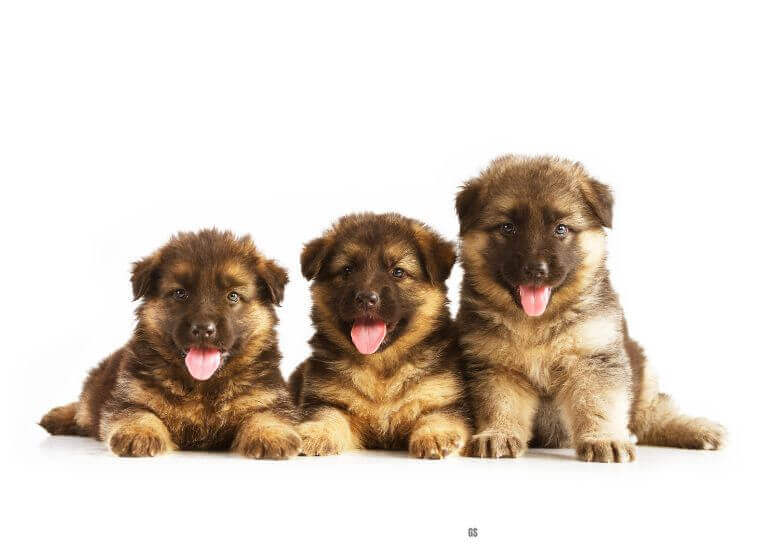Table of Contents
Your German Shepherd puppy is sure to change a lot within the first months in terms of its height and weight. It will turn into athletic and muscular adult dogs from a funny, fluffy cub. It will be full of energy, speed, and agility, like a true herding and guiding friend.
However, many dog owners are excited about how big, tall, and heavy their Shepherd should grow up to adulthood. German Shepherd growth is the subject matter of concern for both breeders and owners. The variety of sizes, like the variety of colors, is amazing.
Nevertheless, the American Kennel Club has defined the average parameters of a purebred GSD. They are called a breed standard and are used to describe an ideal canine of this breed. In general, an average male reaches 24-26 inches (61-66 cm) in height and 65-90 pounds (29-41 kg) in weight, while an average female should be 22-24 inches (56-61 cm) tall and 50-70 pounds (23-32 kg) heavy. The body of both males and females should be longer than their height.
From very birth, German Shepherds grow and develop quickly, and this growth does not completely stop until their senior age. Like people and other species in the world, German Shepherds cannot entirely correspond to all these criteria. How tall and heavy a puppy will grow depends on many factors. Genetics, health, temperament as well as nutrition, care, socialization, and training influence a lot in the overall size of an adult dog. To be on the safe side, you can consult the German Shepherd growth chart provided here and consider the information in this article.
The representatives of two different breed lines – show and working dogs – also differ in size. You need to know that the age of the dog also affects its size. Their lifespan is not long – just about 10-13 years, and they go through various stages of development during these years. This article describes all these stages to let you be sure that your German Shepherd puppy develops correctly.
Male German Shepherd Growth Chart
| Age | Male GSD Weight | Male GSD Height | % of Adult Weight |
|---|---|---|---|
| 1 Month | 5.5-9 lbs (2.5-4 kg) | 4-6 inch (10-15 cm) | 10% |
| 2 Months | 16-20 lbs (7-9 kg) | 7-9 inch (18-23 cm) | 22% |
| 3 Months | 22-30 lbs (10-13.5 kg) | 9-11 inch (23-28 cm) | 40% |
| 4 Months | 35-40 lbs (16-18 kg) | 11-14 inch (28-35 cm) | 50% |
| 5 Months | 40-49 lbs (18-22 kg) | 14-16 inch (35-40 cm) | 60% |
| 6 Months | 49-57 lbs (22-26 kg) | 16-18 inch (40-45 cm) | 70% |
| 7 Months | 57-62 lbs (26-28 kg) | 19-20 inch (48-51 cm) | 80% |
| 8 Months | 62-66 lbs (28-30 kg) | 20-22 inch (51-56 cm) | 85% |
| 9 Months | 64-71 lbs (29-32 kg) | 21-23 inch (53-58 cm) | 90% |
| 10 Months | 66-73 lbs (30-33 kg) | 22-24 inch (56-61 cm) | 92% |
| 11 Months | 66-75 lbs (30-34 kg) | 22-24 inch (56-61 cm) | 95% |
| 1 Year | 71-75 lbs (32-34 kg) | 22-24 inch (56-61 cm) | 95% |
| 1,5 Years | 71-79 lbs (32-36 kg) | 23-25 inch (58-63 cm) | 98% |
| 2 Years | 71-84 lbs (32-38 kg) | 24-26 inch (61-66 cm) | 99% |
| 3 Years | 79-88 lbs (36-40 kg) | 24-26 inch (61-66 cm) | 100% |
Female German Shepherd Growth Chart
| Age | Female GSD Weight | Female GSD Height | % of Adult Weight |
|---|---|---|---|
| 1 Month | 4.5-8 lbs (2-3.5 kg) | 3-6 inch (7.5-15 cm) | 10% |
| 2 Months | 11-17 lbs (5-7.7 kg) | 6-9 inch (15-23 cm) | 22% |
| 3 Months | 17-26 lbs (7.7-12 kg) | 8-10 inch (20-25 cm) | 40% |
| 4 Months | 31-35 lbs (14-16 kg) | 10-12 inch (25-30 cm) | 50% |
| 5 Months | 35-44 lbs (16-20 kg) | 12-14 inch (30-35 cm) | 60% |
| 6 Months | 44-49 lbs (20-22 kg) | 15-17 inch (38-43 cm) | 70% |
| 7 Months | 49-53 lbs (22-24 kg) | 17-19 inch (43-48 cm) | 80% |
| 8 Months | 53-57 lbs (24-26 kg) | 18-20 inch (46-51 cm) | 85% |
| 9 Months | 55-60 lbs (25-27 kg) | 19-21 inch (48-53 cm) | 90% |
| 10 Months | 57-62 lbs (26-28 kg) | 19-21 inch (48-53 cm) | 92% |
| 11 Months | 60-64 lbs (27-29 kg) | 20-22 inch (51-56 cm) | 95% |
| 1 Year | 60-65 lbs (27-29.5 kg) | 20-22 inch (51-56 cm) | 95% |
| 1.5 Years | 60-66 lbs (27-30 kg) | 21-22 inch (53-56 cm) | 98% |
| 2 Years | 62-68 lbs (28-31 kg) | 22-24 inch (56-61 cm) | 98% |
| 3 Years | 66-70 lbs (30-32 kg) | 22-24 inch (56-61 cm) | 100% |
Growth Phases of a German Shepherd Dog
If you care about your dog’s health and well-being, it is vitally important to know the recommended weights and heights of German Shepherds, as well as the most common behavioral and development patterns at every phase of growth. If your puppy’s parameters more or less correspond to these characteristics, you may be sure that it will grow healthy and agile. Let’s start with the very initial German Shepherd puppy growth stages.
Puppyhood
The first growth phase – puppyhood – has six development stages. It finishes by the end of the 6th month of GS puppy’s life. During each of these stages, a puppy learns a lot of things. It is worth knowing them to follow your pet’s development accurately.
Neonatal Stage
This period lasts from birth to 13 days. The puppy needs a lot of nursing from its mom because it is rather helpless. Its ears and eyes are closed, so it does not have any senses. The little pups should completely rely on their mothers for nourishment and care. By 2 weeks, they double their birth weight. They start crawling, and then their eyes and ears begin to open. The first milk teeth appear. The puppy can even stand up, but too unstably and shakily.
2-3 Weeks Old German Shepherd
At the end of the second week, puppies can already stand up and their eyes and ears are open. This makes it possible for little ones to hear, smell, and taste. They even try to walk. Their baby teeth continue growing. The period between 2-4 weeks is also called a transitional one. At the end of the third week, the motor skills start developing fast. The puppy can already control its temperature and body, namely, bowel movements. It begins to interact with its littermates.
Nevertheless, the pup is still largely dependent on its mother. Though, you can interact with it. At the end of this period, the little cub is ready to explore the world. Its baby teeth are almost complete, and it can stand up more stably.
3-4 Weeks Old German Shepherd
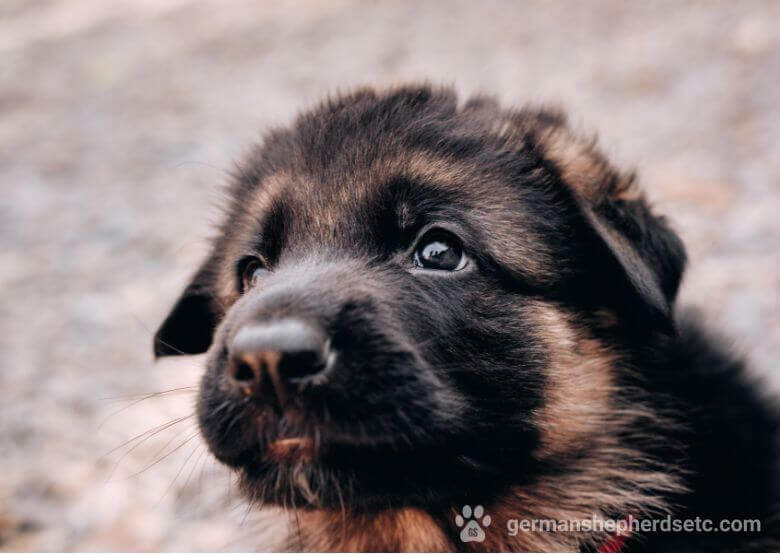
At the end of month one, the GS puppy is more independent and curious. It starts barking and growling a bit. You can introduce some kibble to mother’s milk. The puppy grows quickly now. It actively interacts with its littermates. The baby dog can walk, and its baby teeth are complete.
4-5 Weeks Old German Shepherd
The socialization period starts when the puppy can begin to interact with other animals and people. You can also consider the German Shepherd behavior stages from now. Its mental development starts because it discovers the world actively with its senses. The baby’s teeth have completely erupted and are ready for the next stage.
At this age, the puppy needs to stay close to the mother’s side because it has to learn some discipline. Its walking improves, and it can make attempts to run, so it can even sometimes get in trouble.
5-7 Weeks Old German Shepherd
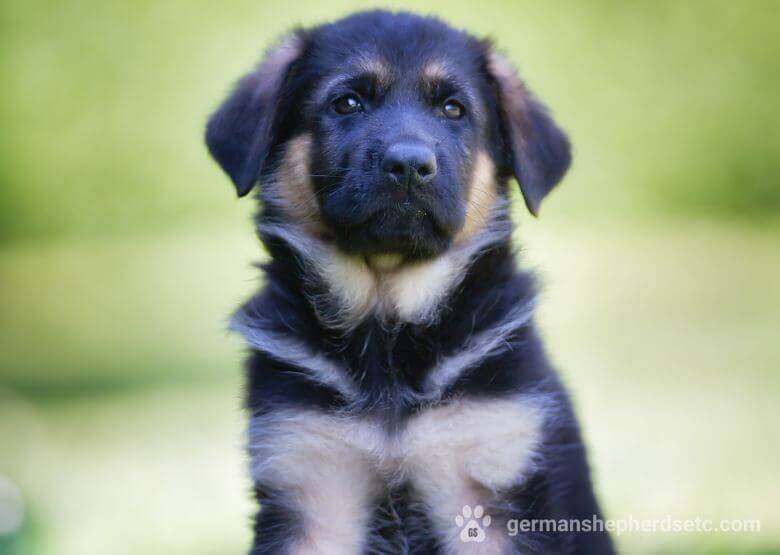
Socialization and growth continue. The puppy can start eating dog food. That is why it is important to begin weaning. The little one can recognize and greet its littermates and people, get interested in new things, and continue to explore the world. However, at this age, the first fear period can be experienced.
Read our detailed guide about 6 week old German Shepherd puppy.
7-12 Weeks Old German Shepherd

By the 8th week, the puppy’s weaning can be completed, and it can socialize away from its mother. It is the best period for taking your pet home. However, be careful about the puppy’s signs of fearfulness that may last up to the 11th week. This period can be psychologically traumatic, so be careful not to expose the pet to direct sunlight because it may be afraid of it for its entire life. All the fears need your special attention. You need to nurture, but not encourage them.
The puppy’s activity increases, so you can start house training and correct guarding behavior. The baby dog’s ears display the first attempt to stand straight. The little German Shepherd’s height is increasing, but it is still under one foot tall.
Read our detailed guide about 2 month old German Shepherd puppy.
So, your puppy is three months old now. It is playful and active. Its teeth are complete. It is weaned and eats dog food. The feeding recommendation here is the overall one and a half cups, three times a day.
It is also time to get your pet vaccinated against distemper and parvovirus.
At the end of the third month, your little GSD can simulate its behavior after other dogs and humans. Training can start.
Read our detailed guide about 3 month old German Shepherd puppy.
Juvenile Phase (3-6 Months)
Therefore, the third month of your GS puppy’s life comes to the end, and the next phase – Juvenile Growth or Seniority Period – starts.
Your puppy already has all its baby teeth, and adult canines and incisors begin to push through. It can even try to bite or nip you. The puppy coat begins to disappear and gets ready for replacement by the adult double-layer coat. You can see a racing stripe on its spine where the adult hair will grow.
The puppy displays quick growth at this time, and it becomes stronger to withstand the possible fierce competition with its siblings if it is still staying with its family. It needs a lot of biting and chewing now for the correct growth of its adult teeth.
Your pet needs consistent socialization and potty training now. After three months old, you should think about such vaccination as DHPP – distemper, hepatitis, parainfluenza, and parvovirus.
The juvenile phase lasts from 3 to 6 months, and it can be divided into three stages by month.
4-Month-Old German Shepherd
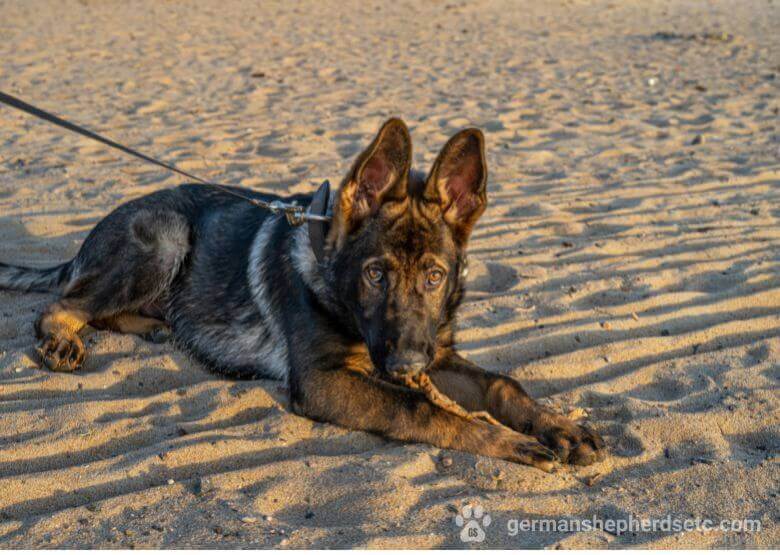
At this time, your puppy may become very active and playful. Don’t allow it to get into trouble. Continue socializing and start more substantial training. Your little pup has grown fast, and it has already reached one foot in height and about 50% of its adult weight. You can consult the German Shepherd weight chart here to see whether your pup develops properly. So, be attentive to the games you play with your pet. Some of them can be dangerous and traumatic because your puppy may not know how to manage its body during them.
The little German Shepherd’s ears continue to perk up, and its teething develops according to the adult pattern. You can give it two cups of kibble totally three times per day because it needs a lot of nutrition to grow. DHPP and rabies vaccines are recommended at this age.
Your little pup is ready to explore the world. However, as a true teenager, it can become more stubborn and try not to listen to your commands. It starts to understand dominance and tries to persuade you in its leadership.
Read our detailed guide about 4 month old German Shepherd puppy.
5-Month-Old German Shepherd

Your puppy continues growing very fast. During this month, it can gain about 10 pounds (4.5 kg) in weight. Its ears have stably perked up by this time. It looks more like an adult dog but, as a true teenager, it is very playful and is always ready to go around. The adult teeth continue to appear. Sexual maturity starts emerging.
You should feed your pet around two cups three times per day. A lot of training is also needed.
Read our detailed guide about 5 month old German Shepherd puppy.
6-Month-Old German Shepherd

Your little German Shepherd becomes even more independent, and it may continue misbehaving and trying to establish dominance. It needs a lot of training and positive reinforcement. Now, your pet is fully house-trained, and it needs a lot of new experiences.
The sixth month is a transition period to the Adolescent Phase. The ears are completely upright. Males achieve sexual maturity, while female puppies can experience heat cycles. Hormones start working, and male puppies can start marking the territory and looking for females to mate.
The adult coat grows longer and gets its normal double layers. Adult teething is about to finish, and all 42 teeth appear.
You should feed your dog with the overall two or three cups two times per day.
By the end of the 6th month, your puppy will reach 60-70% of its adult size.
Read our detailed guide about 6 month old German Shepherd puppy.
Adolescence Phase (6-18 Months)
German Shepherd males are thought to be grown-up when they are 3 years (36 months) old. Females become adults when they are 2 years (24 months) old. However, these criteria differ for every puppy. That is why the adolescence phase lasts from the end of the 6th month to the end of the second year of age (24 months) on average. By the end of this phase, the puppy reaches its full size (though it will continue slightly growing).
Your dog can display testing boundaries, so disobedience is widely encountered if the dog is not properly trained. German Shepherds do not look like puppies anymore. Within this period, some dogs can display their second fear period (at approximately 5-14 months old), though to avoid long-lasting psychological trauma, you should ignore the fears.
Some dogs may occasionally forget their skills that they have already acquired, so you may need to repeat training again. Here, the reinforced training is useful because some puppies can become entirely rambunctious. Your pet will also need more socialization since it reaches its sexual maturity, and some of its reactions can be pretty unexpected.
Let’s have a closer look at some periods within this phase that are characteristic of the dog’s development.
7-Month-Old German Shepherd
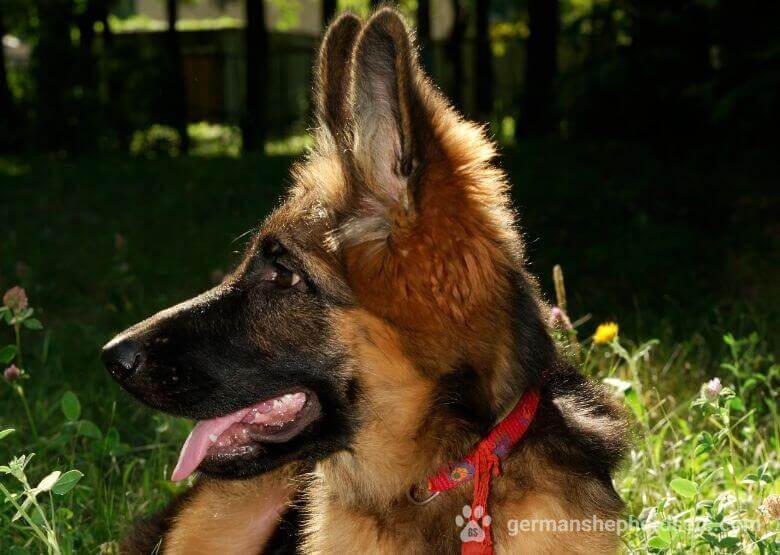
At this age, your dog should be cognitively well-developed. Its sexual maturity continues, which may cause some aggression because of increases and decreases in hormones. The puppy does not gain weight so fast. Teething is finished. The German Shepherd starts looking more similar to an adult dog, with its standing up ears and well-developed muscles.
The food your dog needs involves two or three cups total, given two times per day.
Read our detailed guide about 7 month old German Shepherd puppy.
8-Month-Old German Shepherd
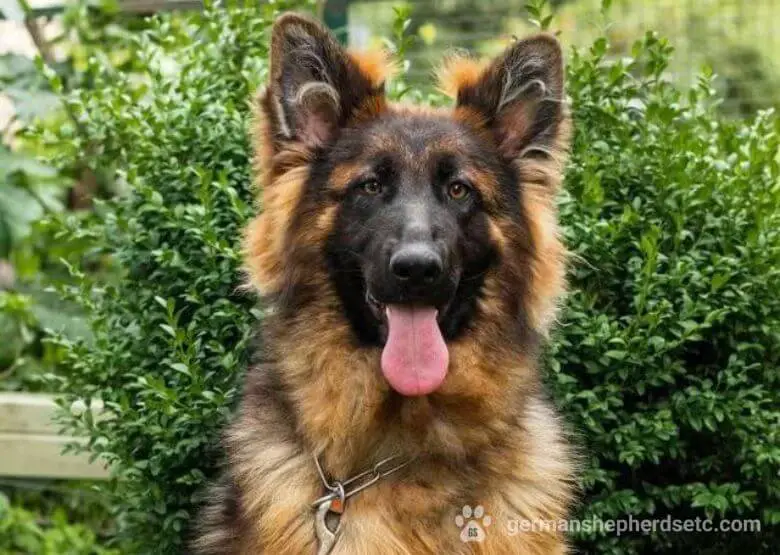
The time passes, and your dog is nothing like your fluffy and cute puppy anymore. It displays a lot of aggression. It can bark or lunge at other animals, kids, and unfamiliar people. A lot of training and reinforcement is needed. You can teach the youngster new tricks to deal with their aggression. The dog has strong adult teeth, and its ears are well-formed and perky. The transition to adulthood continues.
As for food, your dog needs two-three cups in total two times a day.
Read our detailed guide about 8 month old German Shepherd puppy.
9-Month-Old German Shepherd

Your dog has reached all its essential characteristic features. It has a full set of 42 teeth, nice perky ears, and almost 90% of its size and weight. It does not grow fast, gaining about a couple of pounds per month.
The dog needs two-three cups of food two times a day.
Read our detailed guide about 9 month old German Shepherd puppy.
10-Month-Old German Shepherd
At this age, German Shepherds still behave like teenagers, so they can get into some trouble. They are very active and need a lot of attention and training. Sometimes, they can be really goofy or clumsy because they are still learning and do not know how to behave in many events. Your pup is very smart and clever but tends to display a lot of aggression if not supported and reinforced properly. It is still slowly growing and reaches 92% of its adult size.
The dogs should eat two-three cups in total per day.
Read our detailed guide about 10 month old German Shepherd puppy.
11-Month-Old German Shepherd
As your dog becomes more adult, it gets more stubborn. It starts to challenge you as an owner and likes to demonstrate its leadership. You should teach it to be responsible and obey your commands. A lot of training and reinforcement is crucial. The growth slows down, and your dog reaches 95% of its adult German Shepherd size and weight.
Still, give it two or three cups in total per day.
12-14 Months Old German Shepherd
The end of the first year of life is marked by the apparent transition from the adolescence to adulthood phases. At this age, the dog’s bond with its owner is very strong, though it can occasionally misbehave and still needs a lot of proper training. It becomes a bit destructive, but be sure not to get angry or upset with it. It needs your patience and positive attitude. Furthermore, it grows very slowly and almost reaches 98% of its adult size.
Such vaccines as DHPP and rabies are recommended at this age. It should also transit to adult food. Give it three or three and a half cups total twice a day.
Read our detailed guide about 1 year old German Shepherd puppy.
Years 1.5 (14-18 months) – The First Transition Phase
The young German Shepherd has almost reached its adulthood. This time is considered a transition period. The dog may have problems with fears and memory breakdowns. It may even forget how to do familiar things and should be trained again. However, its attention span is longer at this age, so it can have a more thorough obedience training. They have only 1-2% of adult German Shepherd weight to gain and approach their complete sexual maturity.
The dog should eat three or three and a half cups two times a day.
Year 2 (18-24 months) – The Second Transition Phase

This is one more transition period known as young adulthood. Your dog still displays some aggression. That is why they continue to need reinforcement, training, and socialization. It’s the time when your puppy turns into a loyal, obedient, alert, and courageous German Shepherd dog. It has already gained its athletic frame and strong muscle, and only several pounds are lacking for reaching its adult weight. In fact, you get a German Shepherd full-grown pet now.
The DHPP vaccination is recommended at this age.
Continue to feed your dog with three to three and a half cups in total twice per day.
Adulthood Phase (24 months+)
Now, your German Shepherd has completely developed into a mature grown-up dog, both physically and mentally. It has become a loyal and protective family pet or an obedient and enduring working dog.
The young adulthood stage lasts from the second to the third year after the puppy was born. Its size is typical now for an adult dog. However, it may continue to grow slightly, but the changes are not noticeable at all.
At this phase, you can also notice that your pet becomes more and more active. It needs a lot of exercise and training. A lot of physical activity is essential for the dog to stay in high spirits.
The period between the second and third years of life is also called the adult growth stage. This is the time when your friend gets its excellent breed characteristics. It loves attention very much and continues to learn new things eagerly. The dog enjoys training sessions and strives for new experiences. It becomes calmer and more confident. Its hyperactivity slightly decreases.
The German Shepherd reaches its complete sexual maturity, with the height and weight of a 100% Shepherd dog. It displays a lot of self-control and discipline.
Continue feeding your dog with three to three and a half cups twice per day. It will be its constant adult diet. Vaccination against rabies is recommended and required by authorities at this age.
Seniority Phase
This is the last phase of German Shepherd development. It may seem wonderful, but your dog can continue to slightly grow. The phase is divided into two periods – early senior (6-9 years old) and late senior (9-12 years old).
Early Senior Period (6-9 Years Old GSD)
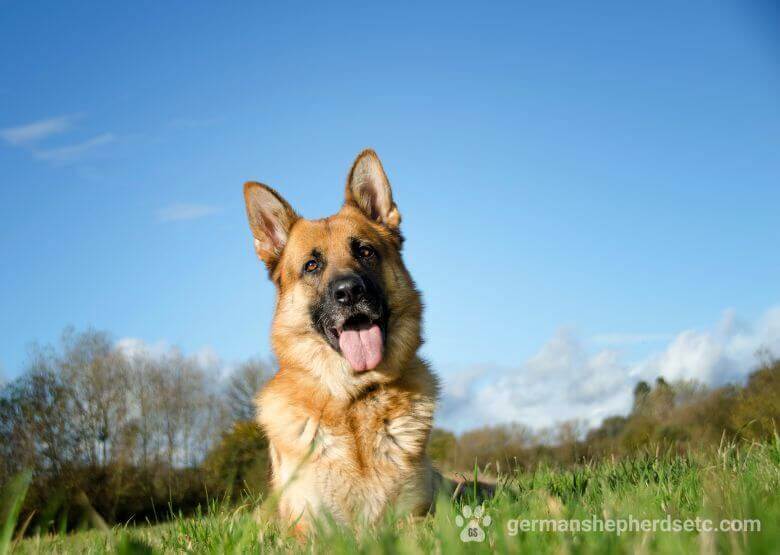
When the German Shepherd is over 6 years old, it enters the senior phase of development. Unfortunately, you need to focus on its health rather than on training. Such health issues as hip dysplasia, joint pain, and decreased stamina can appear at this age. You need to have consultations with your vet more often.
During this period, your dog does not change its weight and height considerably. Though, you can observe slight changes in weight.
Late Senior Period (9-12 Years Old GSD)
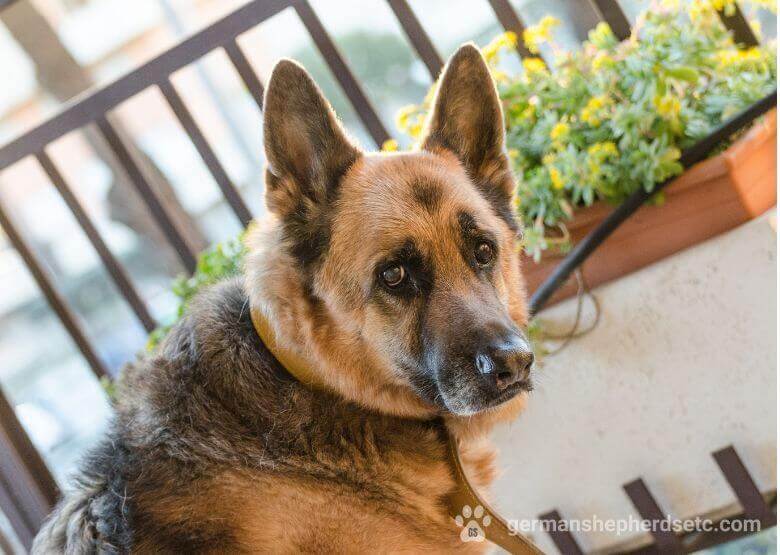
The lifespan of a German Shepherd depends a lot on how well it has been cared for. On average, these dogs live 9-13 years. You need to attend to their health and comfort. The dog may remain energetic and playful, but it slightly slows down. It wants to rest more and gets much calmer.
The animal may suffer from some pains, so it may need pain relievers for spine and joint problems and arthritis. It may also need nutritional supplements and changes to its diet. Special senior and sensitive stomach food may become the best choice. Avoid jumping and hard playing. Continuous veterinary monitoring is needed if some symptoms are worsening.
What You Need to Know About Your German Shepherd’s Growth and Size
Here are some facts you need to know if you want your German Shepherd to grow and develop properly at any age.
Checking the Dog’s Proportions
The standards established by the American Kennel Club imply that German Shepherds should be longer than tall. The accepted proportion that is considered ideal is 10:8.5. The weight is usually not taken into consideration.
If your pet does not correspond to this proportion, there may be a health issue you do not know about yet. That is why you need to monitor the parameters carefully. To be sure that everything is OK, multiply the length of your dog by 0.85. You will get the perfect height. However, there can be some divergences. If they are minor, you have nothing to worry about.
Evaluating the Dog’s Weight
Your dog can belong to one of the three mass evaluation categories:
- Underweight. The German Shepherd is rather thin, or even skinny. This results in bad proportions.
- Perfect. The ideal weight of your German Shepherd is 77-81 lbs (35-37 kg) for males and 66-70 lbs (30-32 kg) for females.
- Overweight. You can get either a heavy or obese dog, and it can be a result of overfeeding or certain health issues.
How to Check the Weight of Your German Shepherd
The simplest method to see whether your dog is underweight is to check whether the ribs are visible on the sides. If you can see that the shape of your dog reminds you of a barrel on the ribs, it means that it is overweight.
You can always feel your dog’s ribs to examine whether its size and weight are normal. If you cannot feel the ribs, but there is too much skin on the sides, your dog is overweight. If you can feel the ribs and only one layer of the skin, your dog’s weight is normal. However, if you feel the ribs and only a thin layer of skin, it is underweight.
How to Get Your German Shepherd’s Weight to the Norm?
It does not matter whether your dog is underweight or overweight. In any case, it can cause health problems if you do not repair the situation. The best way to succeed is to make changes to the diet.
If your German Shepherd is underweight, you should enrich the content of its food. However, do not make it eat if the dog does not want to. That can lead to more severe problems. Make a slow transition to food with higher fat content. Or you may even give your dog puppy food because it is rich in nutrients.
If your pet is obviously overweight, the best thing is to cut off the food. However, you also need to do it step by step so that the dog finally can eat just half of the amount you have recently fed it.
What Are the Average Indicators of the German Shepherd’s Size?
The adult dog has a height of 22-26 inches (56-66 cm) at the shoulder and an average weight of 70-88 pounds (32-40 kg). Nevertheless, some German Shepherds can grow bigger and even reach 100-110 pounds (45-50 kg). You need to be sure about its proportions though to understand if your pet meets the standards. If you see some deficiencies, meet your vet for a more thorough evaluation.
When does a German Shepherd stop growing?
German Shepherd males are thought to be grown-up when they are 3 years old. Females become adults when they are 2 years old. However, these criteria differ for every puppy. That is why the adolescence phase lasts from the end of the 6th month to the end of the second year of age (24 months) on average. By the end of this phase, the puppy reaches its full size (though it will continue slightly growing).
How tall is a German Shepherd?
The adult dog has a height of 22-26 inches (56-66 cm) at the shoulder. An average male reaches 24-26 inches (61-66 cm) in height, while an average female should be 22-24 inches (56-61 cm) tall. The body of both males and females should be longer than their height.
How big do German Shepherds get?
The adult dog has a height of 22-26 inches (56-66 cm) at the shoulder and an average weight of 70-88 pounds (32-40 kg). Nevertheless, some German Shepherds can grow bigger and even reach 100-110 pounds (45-50 kg).
How much does a German Shepherd weight?
In general, an average male reaches 65-90 pounds (29-41 kg) in weight, while an average female should be 50-70 pounds (23-32 kg) heavy.
Final Thoughts
The GSD is a great breed known for its trainability, loyalty, and high intellect. This is a very strong and brave dog that can become a perfect guardian and protector. If you decide to take a GS puppy, you need to follow its growth stages accurately to be sure that it develops properly. Every phase and stage is important for your pet’s growth and maturation. You should follow a high-quality diet, provide your dog with a lot of exercise, and ensure its proper training and socialization.
Your German Shepherd cannot stay healthy and active if it gets some health problems related to its weight or height. Sometimes, these issues are not obvious and understandable to the owner. That is why it is important to know the main development parameters of your German Shepherd growth stages to cope with possible challenges. We hope that this article, together with the weight and height chart, will become your effective and helpful guide.
